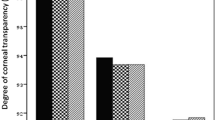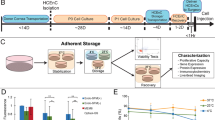Abstract
To evaluate temporary exposure to hyperthermia for its impact on endothelial cell density of porcine corneas in organ culture medium containing dextran with regards to possible negative influences of high temperatures during the storage and transport of corneal grafts. Four groups of central discs (diameter 8 mm) from the corneas of both eyes in 40 pigs were first organ-cultured (MEM with 6% dextran 500) for 24 h at 32°C. Ten corneas were then exposed to 40°C in group 1, to 42°C in group 2, to 44°C in group 3, and to 50°C in group 4 for 12 h each. The paired corneal discs for all groups were not treated, stored at 32°C and served as controls. After further organ culture of all corneas for 48 h at 32°C to allow regenerative processes, corneal endothelium was stained with Alizarin Red S and examined by light microscopy. The endothelial cell densities were determined on three central images using a system for the automatic estimation of morphometric parameters of corneal endothelium. Exposure for 12 h to 40°C as well as to 42°C induced no endothelial cell loss. Statistical analysis showed no significant difference of the endothelial cell density between corneas exposed to 40°C and 42°C and the control corneas (40°C treatment: 4736 ± 426 cells/mm2 and control: 4762 ± 344 cells/mm2, p = 0.74; 42°C treatment: 4240 ± 363 cells/mm2 and control: 4176 ± 448 cells/mm2, p = 0.40). Exposure to 44°C and 50°C lead to total necrosis of the endothelial cell layer. Exposure of organ cultured porcine corneas in dextran containing medium up to 42°C for 12 h does not compromise the endothelial cell density in a clinically relevant manner. Temperatures above 42°C, as it might be the case during transports from the cornea bank to the ophthalmic surgeon, must be strictly avoided as they damage the endothelial cell layer.

Similar content being viewed by others
References
Commission Directive 2006/17/EC (2006). Official Journal of the European Union.
Net M, Trias E, Navarro A, Ruiz A, Diaz P, Fontenla JR, Manyalich M (2003) Cold chain monitoring during cold transportation of human corneas for transplantation. Transplant Proc 35(5):2036–2038
Hu FR, Tsai AC, Wang IJ, Chang SW (1999) Outcomes of penetrating keratoplasty with imported donor corneas. Cornea 18(2):182–187
Varssano D, Russ V, Linhart Y, Lazar M (2005) Air transportation of corneal tissue: experience with local compared to transatlantic donor corneas. Cornea 24(6):674–677
Rosenbaum K, Reinhard T, Sundmacher R (2004) Factors influencing corneal endothelium in organ cultures during transport. Ophthalmologe 101(12):1209–1213
Madden PW, Maguire SH (1996) Methods of refrigerated transport of corneas for transplantation. Aust N Z J Ophthalmol 24(2 Suppl):17–20
Schroeter J, Maier P, Bednarz J, Bluthner K, Quenzel M, Pruss A, Reinhard T (2009) [Procedural guidelines. Good tissue practice for cornea banks]. Ophthalmologe 106(3):265–276
Schroeter J, Meltendorf C, Ohrloff C, Rieck P (2008) Influence of temporary hypothermia on corneal endothelial cell density during organ culture preservation. Graefes Arch Clin Exp Ophthalmol 246(3):369–372
Schroeter J, Meltendorf C (2009) Insulation characteristics of transport containers for organ cultured donor corneas under different ambient temperatures. Klin Monbl Augenheilkd 226(8):629–633
Ruggeri A, Scarpa F, De Luca M, Meltendorf C, Schroeter J (2010) A system for the automatic estimation of morphometric parameters of corneal endothelium in alizarine red-stained images. Br J Ophthalmol 94(5):643–647
Arentsen JJ, Rodriques MM, Laibson PR (1977) Histopathologic changes after thermokeratoplasty for keratoconus. Invest Ophthalmol Vis Sci 16(1):32–38
McDonald MB, Davidorf J, Maloney RK, Manche EE, Hersh P (2002) Conductive keratoplasty for the correction of low to moderate hyperopia: 1 year results on the first 54 eyes. Ophthalmology 109(4):637–649
Donnenfeld ED, Perry HD, Doshi SJ, Biser SA, Solomon R (2004) Hyperthermic treatment of post-LASIK corneal striae. J Cataract Refract Surg 30(3):620–625
Goldblatt WS, Finger PT, Perry HD, Stroh EM, Weiser DS, Donnenfeld ED (1989) Hyperthermic treatment of rabbit corneas. Invest Ophthalmol Vis Sci 30(8):1778–1783
Tauber S, Bowman J, Bango J, Fuerst R (2011) Precise temperature control of donor cornea tissue with reusable passive thermal container. Cornea 30(9):977–982
Armitage WJ, Easty DL (1997) Factors influencing the suitability of organ-cultured corneas for transplantation. Invest Ophthalmol Vis Sci 38(1):16–24
Hagenah M, Bohnke M (1993) Latent endothelial cell damage after experimental corneal cryopreservation. Graefes Arch Clin Exp Ophthalmol 231(9):529–532
Meltendorf C, Ohrloff C, Rieck P, Schroeter J (2007) Endothelial cell density in porcine corneas after exposure to hypotonic solutions. Graefes Arch Clin Exp Ophthalmol 245(1):143–147
Singh G, Bohnke M, von Domarus D, Draeger J, Lindstrom RL, Doughman DJ (1985) Vital staining of corneal endothelium. Cornea 4(2):80–91
Sperling S (1978) Early morphological changes in organ cultured human corneal endothelium. Acta Ophthalmol(Copenh) 56(5):785–792
Singh G, Bohnke M, Draeger J (1984) Endothelial wound healing in organ-cultured pig corneae after mechanical trauma. Fortschr Ophthalmol 81(3):293–295
Bahn CF, Glassman RM, MacCallum DK, Lillie JH, Meyer RF, Robinson BJ, Rich NM (1986) Postnatal development of corneal endothelium. Invest Ophthalmol Vis Sci 27(1):44–51
Jacobsen U, Michels G, Liedtke G, Muller MC, Reim M (1985) Organ-culture of pig cornea - methods, clinical morphology and histology. Ophthalmic Res 17(4):201–201
Pels E, Rijneveld WJ (2009) Organ culture preservation for corneal tissue. Technical and quality aspects. Dev Ophthalmol 43:31–46
Taylor MJ, Hunt CJ (1981) Dual staining of corneal endothelium with trypan blue and alizarin red S: importance of pH for the dye-lake reaction. Br J Ophthalmol 65(12):815–9
Singh G, Böhnke M, von Domarus D (1985) Vital staining of corneal endothelium. Cornea 4:80–91
Gain P, Thuret G, Chiquet C, Dumollard JM, Mosnier JF, Campos L (2001) In situ immunohistochemical study of Bcl-2 and heat shock proteins in human corneal endothelial cells during corneal storage. Br J Ophthalmol 85(8):996–1000
Gain P1, Thuret G, Chiquet C, Dumollard JM, Mosnier JF, Burillon C, Delbosc B, Hervé P, Campos L (2002) Value of two mortality assessment techniques for organ cultured corneal endothelium: trypan blue versus Tunel technique. Br J Ophthalmol 86(3):306–10
Conflict of interest
The authors state no conflict of interest.
Author information
Authors and Affiliations
Corresponding author
Rights and permissions
About this article
Cite this article
Schroeter, J., Ruggeri, A., Thieme, H. et al. Impact of temporary hyperthermia on corneal endothelial cell survival during organ culture preservation. Graefes Arch Clin Exp Ophthalmol 253, 753–758 (2015). https://doi.org/10.1007/s00417-014-2903-0
Received:
Revised:
Accepted:
Published:
Issue Date:
DOI: https://doi.org/10.1007/s00417-014-2903-0




